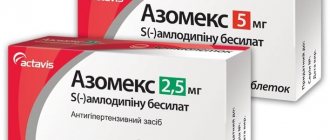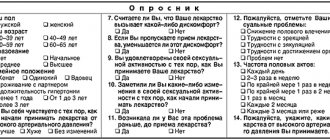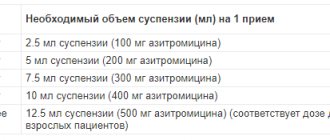Compound
| Film-coated tablets | 1 table |
| active substance: | |
| perindopril tosylate | 2.5/5/10 mg |
| (corresponding to 1.6975/3.395/6.79 mg perindopril) | |
| excipients: lactose monohydrate - 35.981/71.962/143.924 mg; corn starch - 1.35/2.7/5.4 mg; sodium bicarbonate - 0.793/1.586/3.172 mg; pregelatinized corn starch - 3.6/7.2/14.4 mg; povidone-K30 - 0.9/1.8/3.6 mg; magnesium stearate - 0.45/0.9/1.8 mg | |
| film shell (dosage 2.5 mg): Opadry II white 85F18422 (partially hydrolyzed polyvinyl alcohol - 0.9 mg, titanium dioxide (E171) - 0.5625 mg, macrogol-3350 (polyethylene glycol-3350) - 0.4545 mg, talc - 0.333 mg) | |
| film shell (dosage 5 mg): Opadry II green 85F210014 (partially hydrolyzed polyvinyl alcohol - 1.8 mg, titanium dioxide (E171) - 1.0935 mg, macrogol-3350 (polyethylene glycol-3350) - 0.909 mg, talc - 0.666 mg , indigo carmine aluminum varnish (E132) - 0.0144 mg, brilliant blue dye aluminum varnish (E133) - 0.0081 mg, yellow iron oxide dye (E172) - 0.0045 mg, quinoline yellow dye aluminum varnish (E104) - 0 .0045 mg) | |
| film shell (dosage 10 mg): Opadry II green 85F210013 (partially hydrolyzed polyvinyl alcohol - 3.6 mg, titanium dioxide (E171) - 2.133 mg, macrogol-3350 (polyethylene glycol-3350) - 1.818 mg, talc - 1.332 mg, aluminum indigo carmine varnish (E132) - 0.0495 mg, aluminum varnish of brilliant blue dye (E133) - 0.0315 mg, yellow iron oxide dye (E172) - 0.018 mg, aluminum varnish of quinoline yellow dye (E104) - 0.018 mg) |
Perindopril-Teva 5 mg, 30 film-coated tablets
Registration Certificate Holder
Teva Pharmaceutical Industries (Israel)
Dosage form
Medicine - Perindopril-Teva (Perindopril-Teva)
Description
Film-coated tablets
light green, capsule-shaped, biconvex; with a decorative score along the edge of the tablet on both sides; on one side there is an engraving “T”; on a cross section, the core is white or almost white.
1 tab.
perindopril tosylate 5 mg, which corresponds to perindopril 3.395 mg
Excipients
: lactose monohydrate - 71.962 mg, corn starch - 2.7 mg, sodium bicarbonate - 1.586 mg, pregelatinized corn starch - 7.2 mg, povidone K30 - 1.8 mg, magnesium stearate - 0.9 mg.
Shell composition:
Opadry II green 85F210014 (partially hydrolyzed polyvinyl alcohol - 1.8 mg, titanium dioxide (E171) - 1.0935 mg, macrogol 3350 (polyethylene glycol 3350) - 0.909 mg, talc - 0.666 mg, aluminum indigo carmine varnish (E132) - 0.0144 mg, aluminum varnish red owner brilliant blue (E133) - 0.0081 mg, iron oxide yellow dye (E172) - 0.0045 mg, aluminum varnish quinoline yellow dye (E104) - 0.0045 mg).
30 pcs. — polypropylene containers (1) — cardboard packs with first-opening control.
Indications
Arterial hypertension.
Chronic heart failure.
Prevention of recurrent stroke (combination therapy with indapamide) in patients who have had a stroke or transient ischemic cerebrovascular accident.
Stable coronary artery disease: reducing the risk of cardiovascular complications in patients with stable coronary artery disease.
Contraindications for use
History of angioedema, simultaneous use with aliskiren and aliskiren-containing drugs in patients with diabetes mellitus or impaired renal function (GFR <60 ml/min/1.73 m2), pregnancy, lactation, children and adolescents under 18 years of age, hypersensitivity to perindopril, hypersensitivity to other ACE inhibitors.
pharmachologic effect
ACE inhibitor. It is a prodrug from which the active metabolite perindoprilat is formed in the body. It is believed that the mechanism of antihypertensive action is associated with competitive inhibition of ACE activity, which leads to a decrease in the rate of conversion of angiotensin I to angiotensin II, which is a powerful vasoconstrictor. As a result of a decrease in the concentration of angiotensin II, a secondary increase in plasma renin activity occurs due to the elimination of negative feedback during the release of renin and a direct decrease in aldosterone secretion. Thanks to its vasodilating effect, it reduces roundabout percentage (afterload), wedge pressure in the pulmonary capillaries (preload) and resistance in the pulmonary vessels; increases cardiac output and exercise tolerance.
The hypotensive effect develops within the first hour after taking perindopril, reaches a maximum after 4-8 hours and continues for 24 hours.
Clinical studies with the use of perindopril (monotherapy or in combination with a diuretic) have shown a significant reduction in the risk of recurrent stroke (both ischemic and hemorrhagic), as well as the risk of fatal or disabling strokes; major cardiovascular complications, including myocardial infarction, incl. with fatal outcome; stroke-related dementia; serious deterioration of cognitive functions. These therapeutic benefits were observed in both patients with arterial hypertension and those with normal blood pressure, regardless of age, gender, presence or absence of diabetes mellitus, and type of stroke.
It has been shown that with the use of perindopril tertbutylamine at a dose of 8 mg/day (equivalent to 10 mg of perindopril arginine) in patients with stable coronary artery disease, there is a significant reduction in the absolute risk of complications provided for by the main criterion of effectiveness (mortality from cardiovascular diseases, incidence of non-fatal myocardial infarction and/or cardiac arrest followed by successful resuscitation) by 1.9%. In patients who had previously suffered a myocardial infarction or coronary revascularization procedure, the absolute risk reduction was 2.2% compared with the placebo group.
Perindopril is used both as monotherapy and in fixed combinations with indapamide and amlodipine.
Drug interactions
The risk of developing hyperkalemia increases with simultaneous use of perindopril with other drugs that can cause hyperkalemia: aliskiren and aliskiren-containing drugs, potassium salts, potassium-sparing diuretics, ACE inhibitors, angiotensin II receptor antagonists, NSAIDs, heparin, immunosuppressants such as cyclosporine or tacrolimus, trimethoprim.
When used concomitantly with aliskiren in patients with diabetes mellitus or impaired renal function (GFR <60 ml/min), the risk of hyperkalemia, deterioration of renal function and an increase in the incidence of cardiovascular morbidity and mortality increases (in patients of these groups this combination is contraindicated).
Concomitant use with aliskiren is not recommended in patients who do not have diabetes mellitus or impaired renal function, because there may be an increased risk of hyperkalemia, deterioration of renal function, and increased incidence of cardiovascular morbidity and mortality.
The literature has reported that in patients with established atherosclerotic disease, heart failure, or diabetes mellitus with end-organ damage, concomitant therapy with an ACE inhibitor and an angiotensin II receptor antagonist is associated with a higher incidence of hypotension, syncope, hyperkalemia, and deterioration of renal function (including acute renal failure) compared with the use of only one drug that affects the RAAS. Dual blockade (for example, when combining an ACE inhibitor with an angiotensin II receptor antagonist) should be limited to selected cases with careful monitoring of renal function, potassium and blood pressure.
Concomitant use with estramustine may lead to an increased risk of side effects such as angioedema.
With the simultaneous use of lithium and perindopril, a reversible increase in the concentration of lithium in the blood serum and associated toxic effects is possible (this combination is not recommended).
Simultaneous use with hypoglycemic drugs (insulin, hypoglycemic agents for oral administration) requires special caution, because ACE inhibitors, incl. perindopril, can enhance the hypoglycemic effect of these drugs up to the development of hypoglycemia. As a rule, this is observed in the first weeks of simultaneous therapy and in patients with impaired renal function.
Baclofen enhances the antihypertensive effect of perindopril; with simultaneous use, dose adjustment of the latter may be required.
In patients receiving diuretics, especially those that remove fluid and/or salts, an excessive decrease in blood pressure may be observed at the beginning of perindopril therapy, the risk of which can be reduced by discontinuing the diuretic, replacing fluid or salt loss before starting perindopril therapy, as well as using perindopril at low doses. initial dose with further gradual increase.
In chronic heart failure, when using diuretics, perindopril should be used in a low dose, possibly after reducing the dose of a potassium-sparing diuretic used simultaneously. In all cases, renal function (creatinine concentration) should be monitored in the first weeks of using ACE inhibitors.
The use of eplerenone or spironolactone in doses from 12.5 mg to 50 mg/day and ACE inhibitors (including perindopril) in low doses: in the treatment of heart failure of functional class II-IV according to the NYHA classification with a left ventricular ejection fraction <40% and previously used ACE inhibitors and loop diuretics, there is a risk of developing hyperkalemia (possibly fatal), especially if the recommendations for this combination are not followed. Before using this combination, you must ensure that there is no hyperkalemia or impaired renal function. It is recommended to regularly monitor the concentration of creatinine and potassium in the blood - weekly in the first month of treatment and monthly thereafter.
The simultaneous use of perindopril with NSAIDs (acetylsalicylic acid in a dose that has an anti-inflammatory effect, COX-2 inhibitors and non-selective NSAIDs) may lead to a decrease in the antihypertensive effect of ACE inhibitors. Concomitant use of ACE inhibitors and NSAIDs may lead to deterioration of renal function, including the development of acute renal failure, and an increase in serum potassium, especially in patients with reduced renal function. Use this combination with caution in elderly patients. Patients should receive adequate fluids; It is recommended to carefully monitor renal function, both at the beginning and during treatment.
The hypotensive effect of perindopril may be enhanced when used simultaneously with other antihypertensive drugs, vasodilators, including short- and long-acting nitrates.
Concomitant use of gliptins (linagliptin, saxagliptin, sitagliptin, vitagliptin) with ACE inhibitors (including perindopril) may increase the risk of angioedema due to inhibition of dipeptidyl peptidase IV activity by gliptin.
Concomitant use of perindopril with tricyclic antidepressants, antipsychotic drugs and general anesthesia may lead to increased antihypertensive effects.
Sympathomimetics may reduce the antihypertensive effect of perindopril.
When using ACE inhibitors, incl. perindopril, in patients receiving intravenous gold (sodium aurothiomalate), a symptom complex was described in which facial skin flushing, nausea, vomiting, and arterial hypotension were observed.
Dosage regimen
The initial dose is 1-2 mg/day in 1 dose. Maintenance doses - 2-4 mg/day for congestive heart failure, 4 mg (less often - 8 mg) - for arterial hypertension in 1 dose.
In case of renal dysfunction, adjustment of the dosage regimen is required depending on the CC values.
Side effect
From the hematopoietic system:
eosinophilia, decreased hemoglobin and hematocrit, thrombocytopenia, leukopenia/neutropenia, agranulocytosis, pancytopenia, hemolytic anemia in patients with congenital deficiency of glucose-6-phosphate dehydrogenase.
From the side of metabolism:
hypoglycemia, hyperkalemia, reversible after discontinuation of the drug, hyponatremia.
From the nervous system:
paresthesia, headache, dizziness, vertigo, sleep disturbances, mood lability, drowsiness, fainting, confusion.
From the senses:
visual impairment, tinnitus.
From the cardiovascular system:
excessive decrease in blood pressure and associated symptoms, vasculitis, tachycardia, palpitations, cardiac arrhythmias, angina pectoris, myocardial infarction and stroke, possibly due to excessive decrease in blood pressure in high-risk patients.
From the respiratory system:
cough, shortness of breath, bronchospasm, eosinophilic pneumonia, rhinitis.
From the digestive system:
constipation, nausea, vomiting, abdominal pain, taste disturbance, dyspepsia, diarrhea, dry oral mucosa, pancreatitis, hepatitis (cholestatic or cytolytic).
For the skin and subcutaneous fat:
skin itching, rash, photosensitivity, pemphigus, increased sweating.
Allergic reactions:
angioedema, urticaria, erythema multiforme.
From the musculoskeletal system:
muscle spasms, arthralgia, myalgia.
From the urinary system:
renal failure, acute renal failure.
From the reproductive system:
erectile disfunction.
General reactions:
asthenia, chest pain, peripheral edema, weakness, fever, falls.
From the laboratory parameters:
increased activity of liver transaminases and bilirubin in the blood serum, increased concentrations of urea and creatinine in the blood plasma.
special instructions
Carefully
Perindopril should be used for bilateral renal artery stenosis or renal artery stenosis of a single kidney; renal failure; systemic connective tissue diseases; therapy with immunosuppressants, allopurinol, procainamide (risk of developing neutropenia, agranulocytosis); decreased blood volume (taking diuretics, salt-restricted diet, vomiting, diarrhea); angina pectoris; cerebrovascular diseases; renovascular hypertension; diabetes mellitus; chronic heart failure functional class IV according to the NYHA classification; simultaneously with potassium-sparing diuretics, potassium preparations, potassium-containing table salt substitutes, and lithium preparations; with hyperkalemia; surgery/general anesthesia; hemodialysis using high-flow membranes; desensitizing therapy; LDL apheresis; condition after kidney transplantation; aortic stenosis/mitral stenosis/hypertrophic obstructive cardiomyopathy; in patients of the Negroid race.
Cases of hypotension, syncope, stroke, hyperkalemia and renal dysfunction (including acute renal failure) have been reported in predisposed patients, especially when used concomitantly with drugs that affect the RAAS. Therefore, dual blockade of the RAAS by combining an ACE inhibitor with an angiotensin II receptor antagonist or aliskiren is not recommended.
Before starting treatment with perindopril, a renal function test is recommended for all patients.
During treatment with perindopril, renal function, the activity of liver enzymes in the blood, and peripheral blood tests should be regularly monitored (especially in patients with diffuse connective tissue diseases, in patients receiving immunosuppressive drugs, allopurinol). Patients with sodium and fluid deficiency must undergo correction of water and electrolyte disturbances before starting treatment.
Use during pregnancy and breastfeeding
Restrictions during pregnancy - Contraindicated. Restrictions when breastfeeding - Contraindicated.
Perindopril is contraindicated for use during pregnancy and lactation (breastfeeding).
Use for renal impairment
Restrictions for impaired renal function - With caution.
In case of renal dysfunction, adjustment of the dosage regimen is required depending on the CC values.
Use in children
Restrictions for children - Contraindicated.
Contraindicated in children.
Directions for use and doses
Inside.
It is recommended to take 1 time per day, preferably in the morning, before meals.
The dose of the drug is selected individually for each patient, depending on the severity of the disease and individual response to treatment.
Arterial hypertension
The drug Perindopril-Teva can be used in monotherapy and in combination with other antihypertensive drugs.
The recommended starting dose is 5 mg/day, in the morning.
In patients with severe activation of the RAAS (for example, with renovascular hypertension, hypovolemia and/or hyponatremia, decompensated CHF or severe arterial hypertension), a pronounced decrease in blood pressure may develop after taking the first dose of the drug. At the beginning of therapy, such patients should be under close medical supervision. The recommended starting dose is 2.5 mg/day in one dose. If necessary, within a month the dose can be increased to 10 mg/day in one dose and if the previous dose is well tolerated.
The maximum daily dose is 10 mg.
The addition of ACE inhibitors to patients taking diuretics may cause them to develop arterial hypotension. In this regard, it is recommended to carry out therapy with caution, stop taking diuretics 2-3 days before starting treatment with Perindopril-Teva, or start treatment with Perindopril-Teva with an initial dose of 2.5 mg/day in one dose. Monitoring of blood pressure, renal function and serum potassium levels is necessary. In the future, the dose of the drug can be increased depending on the dynamics of blood pressure. If necessary, diuretic therapy can be resumed.
In elderly patients, the recommended initial daily dose is 2.5 mg. In the future, the dose can be gradually increased to 5 mg/day and, if necessary, to a maximum of 10 mg/day in one dose, taking into account the state of renal function.
CHF
The recommended starting dose is 2.5 mg/day in one dose, in the morning, under medical supervision. After 2 weeks, the dose can be increased to 5 mg/day in one dose, under blood pressure monitoring. Treatment of symptomatic CHF is usually combined with potassium-sparing diuretics, beta-blockers and/or digoxin.
In patients with CHF, renal failure and a tendency to water and electrolyte disturbances (hyponatremia), as well as in patients taking diuretics and/or vasodilators at the same time, treatment with Perindopril-Teva begins under strict medical supervision.
In patients at high risk of developing clinically significant arterial hypotension (for example, when taking high doses of diuretics), if possible, hypovolemia and fluid and electrolyte disturbances should be eliminated before starting Perindopril-Teva. It is recommended to carefully monitor blood pressure, renal function and serum potassium levels before and during therapy.
Prevention of recurrent stroke (combination therapy with indapamide)
In patients with a history of cerebrovascular disease, therapy with Perindopril-Teva should be started with a dose of 2.5 mg for the first 2 weeks, then increased to 5 mg over the next 2 weeks before using indapamide. Therapy should be started at any time (from 2 weeks to several years) after a stroke.
Stable ischemic heart disease
In patients with stable coronary artery disease, the recommended initial dose of Perindopril-Teva is 5 mg/day in one dose. After 2 weeks, the dose is increased to 10 mg/day in one dose, provided that the dose of 5 mg/day is well tolerated and renal function is monitored.
Special patient groups
Elderly age.
Treatment of elderly patients should begin with a dose of 2.5 mg/day in one dose, which after a week can be increased to 5 mg/day in one dose. If necessary, after another week you can increase the dose to 10 mg/day in one dose with mandatory preliminary monitoring of renal function. In elderly patients, the dose of the drug can be increased only if the previous, lower dose is well tolerated.
Kidney failure.
In patients with renal failure, the dose of the drug should be adjusted taking into account creatinine Cl.
Recommended doses:
| Creatinine Cl | Recommended dose |
| greater than or equal to 60 ml/min | 5 mg/day daily |
| more than 30 and less than 60 ml/min | 2.5 mg/day daily |
| more than 15 and less than 30 ml/min | 2.5 mg/day every other day |
| Patients on hemodialysis* (less than 15 ml/min) | 2.5 mg/day on the day of dialysis |
*Dialysis clearance of perindoprilate is 70 ml/min.
The drug Perindopril-Teva must be taken after a dialysis session.
Liver diseases.
No dose adjustment is required.
If one or more doses are missed at the next dose, Perindopril-Teva should be taken at the usual dose; You cannot take a higher dose.



